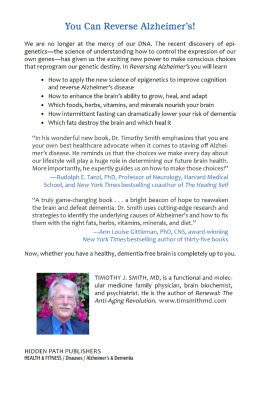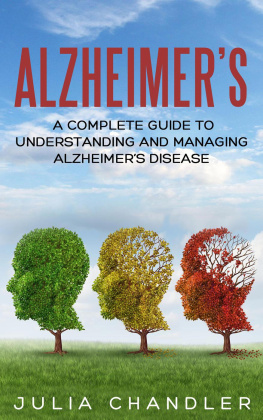Alzheimers Disease and Infectious Causes
McFarland Health Topics
Living with Multiple Chemical Sensitivity: Narratives of Coping. Gail McCormick. 2001
Graves Disease: A Practical Guide. Elaine A. Moore with Lisa Moore. 2001
Autoimmune Diseases and Their Environmental Triggers. Elaine A. Moore. 2002
Hepatitis: Causes, Treatments and Resources. Elaine A. Moore. 2006
Arthritis: A Patients Guide. Sharon E. Hohler. 2008
The Promise of Low Dose Naltrexone Therapy: Potential Benefits in Cancer, Autoimmune, Neurological and Infectious Disorders. Elaine A. Moore and Samantha Wilkinson. 2009
Understanding Multiple Chemical Sensitivity: Causes, Effects,Personal Experiences and Resources. Els Valkenburg. 2010
Type 2 Diabetes: Social and Scientific Origins, Medical Complications and Implications for Patients and Others. Andrew Kagan, M.D. 2010
The Amphetamine Debate: The Use of Adderall, Ritalin and Related Drugs for Behavior Modification, Neuroenhancement and Anti-Aging Purposes. Elaine A. Moore. 2011
CCSVI as the Cause of Multiple Sclerosis: The Science Behind the Controversial Theory. Marie A. Rhodes. 2011
Coping with Post-Traumatic Stress Disorder: A Guide for Families, 2d ed. Cheryl A. Roberts. 2011
Living with Insomnia: A Guide to Causes, Effects and Management,with Personal Accounts. Phyllis L. Brodsky and Allen Brodsky. 2011
Caregivers Guide: Care for Yourself While You Care for Your Loved Ones. Sharon E. Hohler. 2012
You and Your Doctor: A Guide to a Healing Relationship,with Physicians Insights. Tania Heller, M.D. 2012
Advances in Graves Disease and Other Hyperthyroid Disorders. Elaine A. Moore with Lisa Marie Moore. 2013
Cancer, Autism and Their Epigenetic Roots. K. John Morrow, Jr. 2014
Living with Bipolar Disorder: A Handbook for Patients and Their Families. Karen R. Brock, M.D. 2014
Cannabis Extracts in Medicine: The Promise of Benefits in Seizure Disorders, Cancer and Other Conditions. Jeffrey Dach, M.D., Elaine A. Moore and Justin Kander. 2015
Managing Hypertension: Tools to Improve Health and Prevent Complications. Sandra A. Moulton. 2016
Mammography and Early Breast Cancer Detection:How Screening Saves Lives. Alan B. Hollingsworth, M.D. 2016
Living with HIV: A Patients Guide, 2d ed. Mark Cichocki, RN. 2017
Central Sensitization and Sensitivity Syndromes: A Handbook for Coping. Amy Titani. 2017
Hurting Like Hell, Living with Gusto: My Battle with Chronic Pain. Victoria Stopp. 2017
Autogenic Training: A Mind-Body Approach to the Treatment of Chronic Pain Syndrome and Stress-Related Disorders, 3d ed. Micah R. Sadigh. 2019
Alzheimers Disease and Infectious Causes: The Theory and Evidence. Elaine A. Moore. 2020
Alzheimers Disease and Infectious Causes
The Theory and Evidence
Elaine A. Moore
McFarland Health Topics

McFarland & Company, Inc., Publishers
Jefferson, North Carolina
This book is intended as an educational resource and not as a substitute for medical advice.
All illustrations are by Marvin G. Miller.
ISBN (print) 978-1-4766-7861-0 ISBN (ebook) 978-1-4766-3891-1
Library of Congress and British Library cataloguing data are available
Library of Congress Control Number 2020005712
2020 Elaine A. Moore. All rights reserved
No part of this book may be reproduced or transmitted in any form or by any means, electronic or mechanical, including photocopying or recording, or by any information storage and retrieval system, without permission in writing from the publisher.
Front cover images 2020 Shutterstock
Printed in the United States of America
McFarland & Company, Inc., Publishers
Box 611, Jefferson, North Carolina 28640
www.mcfarlandpub.com
To Rick, Lisa, Brett, Linda, Brooklyn, and Elimy A team
Acknowledgments
Im grateful to my family and friends for encouraging me to write this book and for understanding when research and writing kept me away from other activities. Special thanks are extended to Marv Miller, my dear friend and illustrator, who created all of the images in this book. My thanks are likewise extended to SammyJo Wilkinson and Randal F. Hubbard for their help in wading through an enormous amount of medical literature.
Id also like to thank the many researchers who have worked to elucidate and explain the causes of Alzheimers disease, especially Lawrence Broxmeyer, MD; Steven Gundry, MD; David Perlmutter, MD; Joseph Mercola, MD; Mark Hyman, MD; and Rodney Dietert, PhD. Id also like to express my gratitude to Layla Milholen at McFarland for always being ready to answer my questions and for being patient as I deliberated for two years, waiting to find an important, fascinating, and meaningful topic to research and write about.
Table of Contents
Preface
When my mother was diagnosed with Alzheimers disease (AD) in 1981, there were no effective therapies for this condition and little was known about its causes. As a clinical chemist with an interest in alternative medicine, I bought her various supplements designed to increase acetylcholine levels and improve memory. My pharmacist brother gave her medications intended to help increase cerebral blood flow. None of these therapies helped. Her gerontologist checked her thyroid, vitamin B12, and folate levels and found them to be within the normal range. All we could do was offer comfort and support as her condition deteriorated.
Over the years, I kept up with advances in AD, volunteered at a nursing home for AD patients, and wrote two books on the subject. From scrutinizing the results of studies presented at international conferences, I learned that a lack of exercise, chronic stress, and a high-sugar diet were considered contributing factors to Alzheimers disease. These factors marginally helped to explain the probable causes in my mothers case.
However, in pondering causes, I recalled hearing about the time that my mother was paralyzed for one year when she was six years old. Too many years have passed to determine the cause of this paralysis, but I had to wonder whether my mother had suffered from reactivation of a herpes virus, particularly Cytomegalovirus , or if she had been infected by a variant of the polio virus or contracted Mycobacterium avium from the chickens our family raised. I also considered the DDT trucks that barreled through our neighborhood in the summers and the pollution from the Lake Erie fish we ate.
This past year, when my husband developed Herpes zoster ophthalmicus (HZO), which is a condition of shingles that affects patients eyes, I was surprised and alarmed to find that recent studies showed a strong association with developing AD within five years. However, it was encouraging to learn that while the risk of dementia remains high, treatment with antiviral drugs reduces this risk by a factor of ten.
I was also surprised to learn that numerous viruses, bacteria, spirochetes, and fungi had been found in the brains of patients with AD. Considering that Treponema pallidum has long been known to cause a similar form of dementia in patients with syphilis, the pieces to this intriguing puzzle grew clearer. However, the question remained regarding whether many different microbes caused the neuroinflammation that leads to AD or if one particular organism was the true cause.















